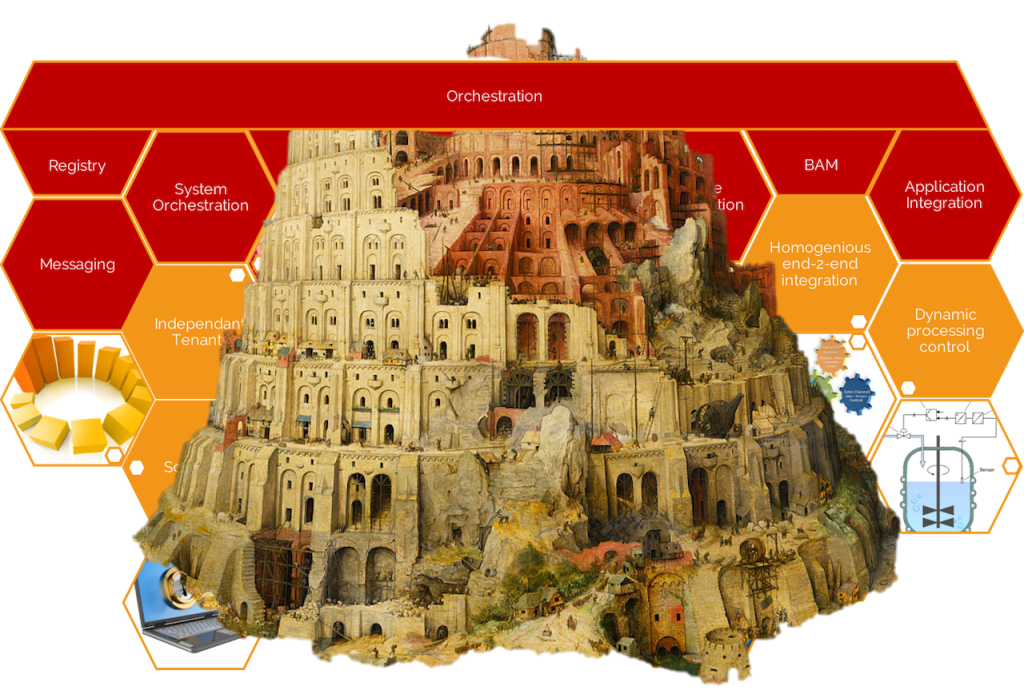What Is Orchestration?

The "Babel" of Orchestration
This post is part of the "Automation-Orchestration" architecture series. Posts of this series together comprise a whitepaper on Automation and Orchestration for Innovative IT-aaS Architectures.
Prior to diving into the architectural patterns for a robust orchestration solution for the enterprise, a few definitions need to be clarified, and as this paper talked a lot about Automation in the first place, we shall begin with outlining precisely the delineation between Automation and Orchestration – to begin with:
- In any IT architecture framework, the automation layer creates the components necessary to provide atomic entities for service orchestration. Automation uses technologies to control, manage and run atomic tasks within machine instances, operating systems and applications on the one hand and provides automation capabilities for the larger ecosystem in order to automate processes (e.g. onboarding a new employee)
- Orchestration – in turn – uses processes, workflows and integration to construct the representation of a service from atomic components. A service could e.g. consist of operations within various different systems such as the creation of a machine instance in a virtual infrastructure, the installation of a webservice in another instance and the alteration of a permission matrix in an IAM system. “Orchestration” would provide means to aggregate these atomic actions into a service bundle which can then be provisioned to a customer or user for consumption. The Orchestration layer makes use of single automated service components.
While the above definitions mainly address the system context in IT architectures, it is valid to say that there is another slightly different context – the service context – which demands for another definition of the term “orchestration”:
- Service orchestration is the coordination and arrangement of multiple services exposed as a single aggregate service. It is used to automate business processes through loose coupling of different services and applications, thereby creating composite services. Service orchestration combines service interactions to create business process models consumable as services.
In order to underpin the danger of confusion when discussing orchestration, here are a few references for orchestration definitions:
- “Orchestration describes the automated arrangement, coordination, and management of complex computer systems, middleware and services.” (wikipedia: https://en.wikipedia.org/wiki/Orchestration_(computing) )
- “Complex Behavior Interaction (Logic/Business Process Level): a complex interaction among different systems. In the context of service-oriented architecture, this is often described as choreography and orchestration” (Carnegie Mellon University Research Showcase 12-2013: “Understanding Patterns for System-of- Systems Integration”, Rick Kazman, Klaus Nielsen, Klaus Schmid)
- “Service orchestration in an ESB allows service requesters to call service providers without the need to know where the service provider is or even the data scheme required in the service” (InfoTech Research Group Inc. “Select and Implement an ESB Solution”, August 2015)
- “Orchestration automates simple or complex multi-system tasks on remote servers that are normally done manually” (ServiceNow Product Documentation: http://wiki.servicenow.com/index.php?title=Orchestration#gsc.tab=0 )
- “The main difference, then, between a workflow “automation” and an “orchestration” is that workflows are processed and completed as processes within a single domain for automation purposes, whereas orchestration includes a workflow and provides a directed action towards larger goals and objectives” (“Cloud Computing: Concepts, Technology & Architecture”, Thomas Erl, Prentice Hall, October 2014)
- “Orchestration is the automated coordination and management of computer resources and services. Orchestration provides for deployment and execution of interdependent workflows completely on external resources” (ORG: http://cloudpatterns.org/mechanisms/orchestration_engine )
Even though these definitions seemingly leave a lot of room for interpretation of what system and service orchestration really covers, clarity can be gained by looking at a few architectural principles as well as requirements for different orchestration goals, which the last few chapters of this paper will be focusing at.




